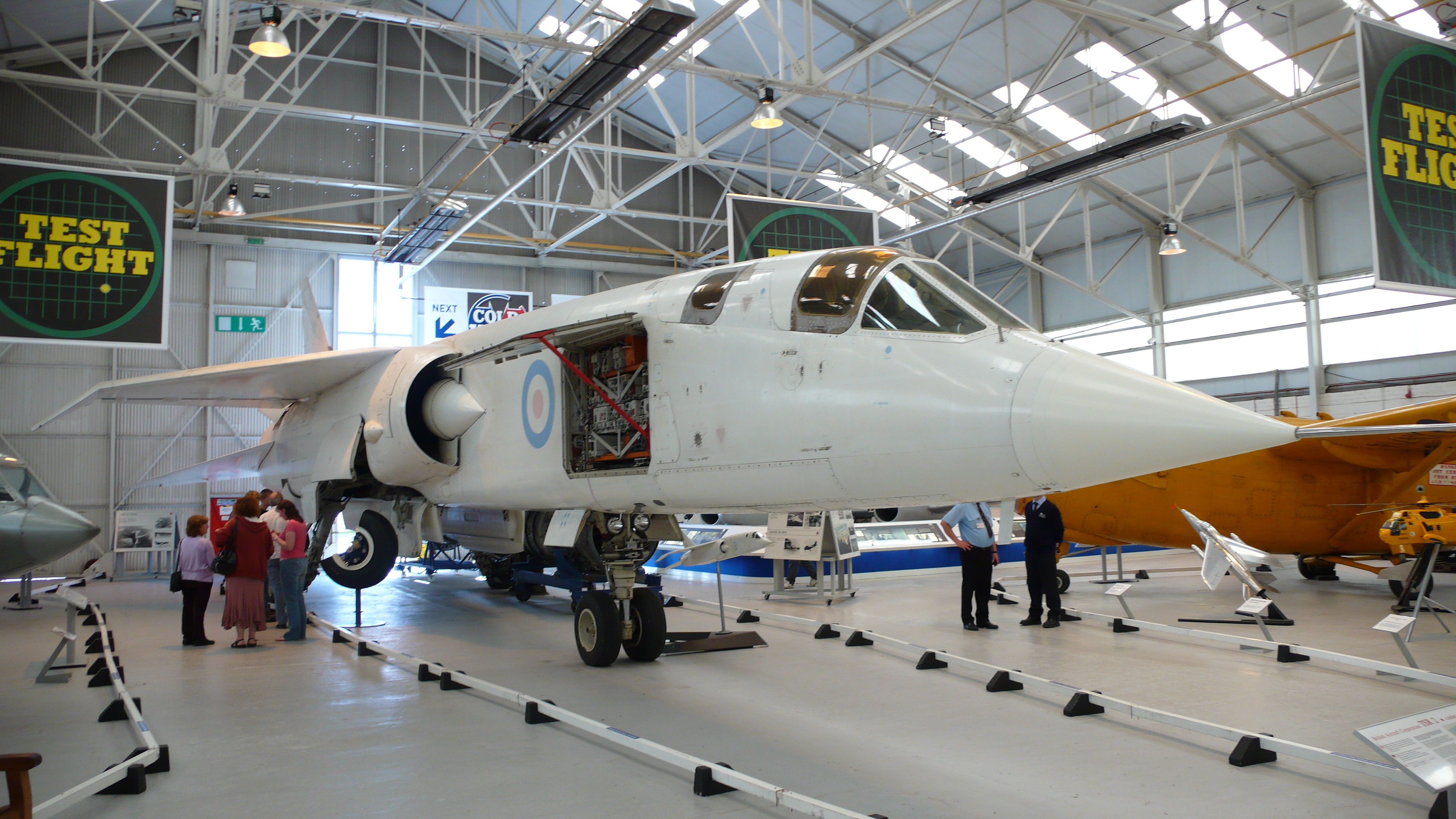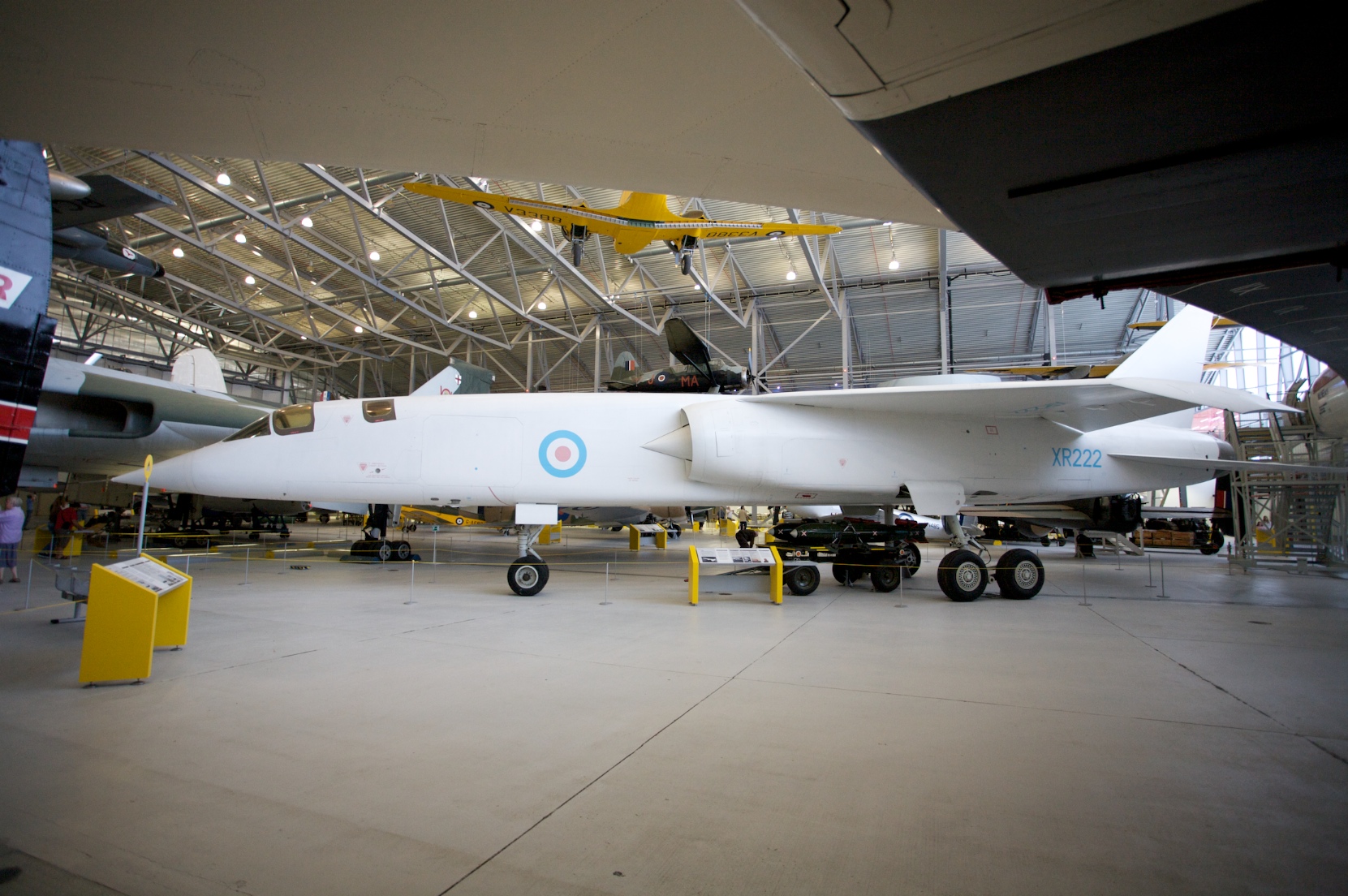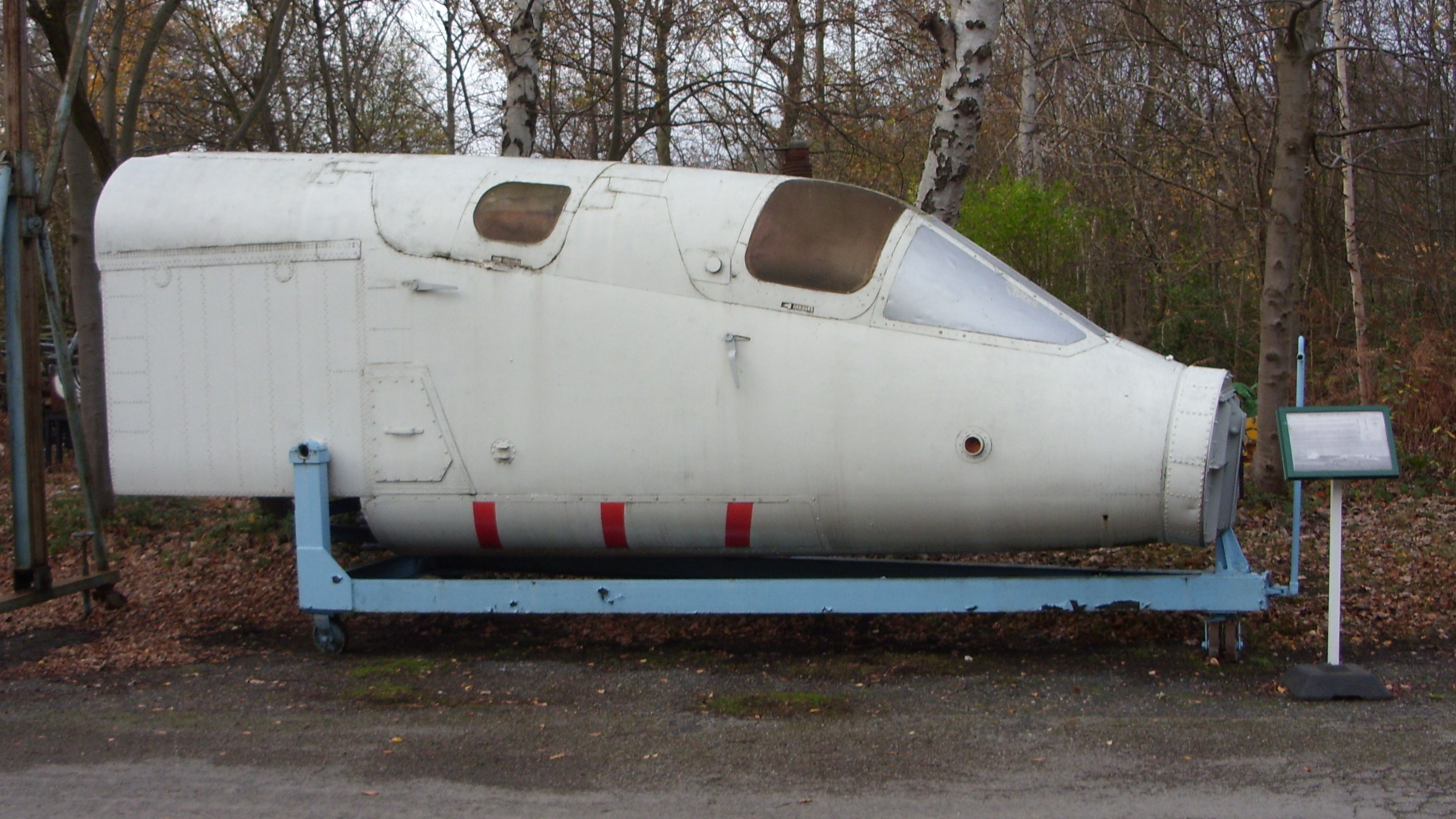
^ The only TSR-2 to fly, XR219 in anti-flash white finish, at BAC's Warton factory in 1966
Introduction
The British Aircraft Corporation TSR-2 was a strike and reconnaissance aircraft project developed by the British Aircraft Corporation (BAC) for the Royal Air Force (RAF) in the late 1950s and early 1960s. The TSR-2 was designed to penetrate a well-defended forward battle area at low altitudes and very high speeds, and then attack high-value targets in the rear with nuclear or conventional weapons. Another intended combat role was to provide high-altitude, high-speed stand-off, side-looking, radar and photo imagery and signals intelligence, reconnaissance. Some of the most advanced aviation technology of the period was incorporated in order to make it the highest-performing aircraft in the world in its projected missions. Only one airframe flew and test flights and weight rise during design indicated that the aircraft would be unable to meet its original stringent design specifications. The design specifications had been reduced as the results of flight testing.
The TSR-2 was the victim of ever-rising costs and inter-service squabbling over Britain's future defence needs, which led to the controversial decision to scrap the programme in 1965. With the election of a new government, the TSR-2 was cancelled due to rising costs, in favour of purchasing an adapted version of the General Dynamics F-111, a decision that itself was later rescinded as costs and development times increased. The replacements included the Blackburn Buccaneer and McDonnell Douglas F-4 Phantom II, both of which had previously been considered and rejected early in the TSR-2 procurement process. Eventually, the smaller swing-wing Panavia Tornado was developed and adopted by a European consortium to fulfil broadly similar requirements to the TSR-2.
Design
Throughout 1959, English Electric (EE) and Vickers worked on combining the best of both designs in order to put forward a joint design with a view to having an aircraft flying by 1963, while also working on merging the companies under the umbrella of the British Aircraft Corporation (along with Bristol Aircraft). EE had put forward a delta winged design and Vickers, a swept wing on a long fuselage. The EE wing, born of their greater supersonic experience, was judged superior to Vickers, while the Vickers fuselage was preferred. In effect, the aircraft would be built 50/50: Vickers the front half, EE the rear.
The TSR-2 was to be powered by two Bristol-Siddeley Olympus reheated turbojets, advanced variants of those used in the Avro Vulcan. The Olympus would be further developed and would power the supersonic Concorde. The design featured a small shoulder-mounted delta wing with down-turned tips, an all-moving swept tailplane and a large all-moving fin. Blown flaps were fitted across the entire trailing edge of the wing to achieve the short take off and landing requirement, something that later designs would achieve with the technically more complex swing-wing approach. No ailerons were fitted, control in roll instead being implemented by differential movement of the slab tailplanes. The wing loading was high for its time, enabling the aircraft to fly at very high speed and low level with great stability without being constantly upset by thermals and other ground-related weather phenomena. The EE Chief Test Pilot, Wing Commander Roland Beamont, favourably compared the TSR-2's supersonic flying characteristics to the Canberra's own subsonic flight characteristics, stating that the Canberra was more troublesome.
According to the Flight Envelope diagram, TSR2 was capable of sustained cruise at Mach 2.05 at altitudes between 37,000 ft (11,000 m) and 51,000 ft (16,000 m) and had a dash speed of Mach 2.35 (with a limiting leading edge temperature of 140 degrees Celsius). Its theoretical maximum speed was Mach 3 in level flight at 45,000 ft (14,000 m).
The aircraft featured some extremely sophisticated avionics for navigation and mission delivery, which would also prove to be one of the reasons for the spiralling costs of the project. Some features, such as forward looking radar (FLR), side-looking radar for navigational fixing, only became commonplace on military aircraft years later. These features allowed for an innovative autopilot system which, in turn, enabled long distance terrain-following sorties as crew workload and pilot input had been greatly reduced.
There were considerable problems with realising the design. Some contributing manufacturers were employed directly by the Ministry rather than through BAC, leading to communication difficulties and further cost overruns. Equipment, an area in which BAC had autonomy, would be supplied by the Ministry from "associate contractors", although the equipment would be designed and provided by BAC, subject to ministry approval. The overall outlay of funds made it the largest aircraft project in Britain to date.
Unlike most previous projects, there were to be no prototypes. Under the "development batch" procedure pioneered by the Americans (and also used by English Electric for the Lightning), there would instead be a development batch of nine airframes, to be built using production jigs. The choice of proceeding to production tooling turned out to be another source of delay, with the first aircraft having to adhere to strict production standards or deal with the bureaucracy of attaining concessions to allow them to exhibit differences from later airframes. Four years into the project, the first few airframes had effectively become prototypes in all but name, exhibiting a succession of omissions from the specification and differences from the intended pre-production and production batches.
Testing
Despite the increasing costs (which were inevitable, given the low original estimates), the first two of the development batch aircraft were completed. Engine development and undercarriage problems led to delays for the first flight which meant that the TSR-2 missed the opportunity to be displayed to the public at that year's Farnborough Airshow. In the days leading up to the testing, Denis Healey, the Opposition defence spokesman, had criticised the aircraft saying that by the time it was introduced it would face "new anti-aircraft" missiles that would shoot it down making it prohibitively expensive at £16 million per aircraft (on the basis of only 30 ordered).
Test pilot Roland Beamont finally made the first flight from the Aeroplane and Armament Experimental Establishment (A&AEE) at Boscombe Down, Wiltshire, on 27 September 1964. Initial flight tests were all performed with the undercarriage down and engine power strictly controlled—with limits of 250 kn (460 km/h) and 10,000 ft (3,000 m) on the first (15-minute) flight. Shortly after takeoff on XR219's second flight, vibration from a fuel pump at the resonant frequency of the human eyeball caused the pilot to throttle back one engine to avoid momentary loss of vision.
Only on the 10th test flight was the landing gear successfully retracted—problems preventing this on previous occasions, but serious vibration problems on landing persisted throughout the flight testing programme. The first supersonic test flight (Flight 14) was achieved on the transfer from A&AEE, Boscombe Down, to BAC Warton. During the flight, the aircraft achieved Mach 1 on dry power only (supercruise). Following this, Beamont lit a single reheat unit only (because of problems with the other engine's reheat fuel pump), with the result that the aircraft accelerated away from the chase Lightning flown by Wing Commander James "Jimmy" Dell, who had to catch up using reheat on both engines. On flying the TSR-2 himself, Dell described the prototype as handling "like a big Lightning".
Over a period of six months, a total of 24 test flights were conducted. Most of the complex electronics were not fitted to the first aircraft, so these flights were all concerned with the basic flying qualities of the aircraft which, according to the test pilots involved, were outstanding. Speeds of Mach 1.12 and sustained low-level flights down to 200 ft (above the Pennines) were achieved. Undercarriage vibration problems continued, however, and only in the final few flights, when XR219 was fitted with additional tie-struts on the already complex landing gear, was there a significant reduction in them. The last test flight took place on 31 March 1965.
Although the test flying programme was not completed and the TSR-2 was undergoing typical design and systems modifications reflective of its sophisticated configuration, "There was no doubt that the airframe would be capable of accomplishing the tasks set for it and that it represented a major advance on any other type."
Costs continued to rise, which led to concerns at both company and government upper management levels, and the aircraft was also falling short of many of the requirements laid out in OR.343, such as takeoff distance and combat radius. As a cost-saving measure, a reduced specification was agreed upon, notably reductions in combat radius to 650 nmi (1,200 km), the top speed to Mach 1.75 and takeoff run up increased from 600 to 1,000 yards (550 to 910 m).
Project Cancellation
By the 1960s, the United States military was developing the swing-wing F-111 project as a follow-on to the Republic F-105 Thunderchief, a fast low-level fighter-bomber designed in the 1950s with an internal bay for a nuclear weapon. There had been some interest in the TSR-2 from Australia for the Royal Australian Air Force (RAAF), but in 1963, the RAAF chose to buy the F-111 instead, having been offered a better price and delivery schedule by the American manufacturer. Nonetheless, the RAAF had to wait 10 years before the F-111 was ready to enter service, by which time the anticipated programme cost had tripled. The RAF was also asked to consider the F-111 as an alternative cost-saving measure. In response to suggestions of cancellation, BAC employees held a protest march, and the new Labour government, which had come to power in 1964, issued strong denials.
"The trouble with the TSR-2 was that it tried to combine the most advanced state of every art in every field. The aircraft firms and the RAF were trying to get the Government on the hook and understated the cost. But TSR-2 cost far more than even their private estimates, and so I have no doubt about the decision to cancel." - Denis Healey, then Minister of Defence.
However, at two Cabinet meetings held on 1 April 1965, it was decided to cancel the TSR-2 on the grounds of projected cost, and instead to obtain an option agreement to acquire up to 110 F-111 aircraft with no immediate commitment to buy. This decision was announced in the budget speech of 6 April 1965. The maiden flight of the second development batch aircraft, XR220, was due on the day of the announcement, but following an accident in conveying the airframe to Boscombe Down, coupled with the announcement of the project cancellation, it never happened. Ultimately, only the first prototype, XR219, ever took to the air. A week later, the Chancellor defended the decision in a debate in the House of Commons, saying that the F-111 would prove cheaper.
Aeronautical engineer Sir Sydney Camm said of the TSR-2: "All modern aircraft have four dimensions: span, length, height and politics. TSR-2 simply got the first three right."
TSR-2 replacements
To replace the TSR-2, the Air Ministry initially placed an option for the F-111K (a modified F-111A with F-111C enhancements) but also considered two other choices: a Rolls-Royce Spey (RB.168 Spey 25R) conversion of a Dassault Mirage IV (the Dassault/BAC Spey-Mirage IV) and an enhanced Blackburn Buccaneer S.2 with a new nav-attack system and reconnaissance capability, referred to as the "Buccaneer 2-Double-Star". Neither proposal was actively pursued as a TSR-2 replacement although a final decision was reserved until the 1966 Defence Review. Defence Minister Healey's memo about the F-111 and the Cabinet minutes regarding the final cancellation of the TSR-2 indicate that the F-111 was preferred.
Following the 1966 Defence White Paper, the Air Ministry decided on two aircraft: the F-111K, with a longer-term replacement being a joint Anglo-French project for a variable geometry strike aircraft - the Anglo French Variable Geometry Aircraft (AFVG). A censure debate followed on 1 May 1967, in which Healey claimed the cost of the TSR-2 would have been £1,700 million over 15 years including running costs, compared with £1,000 million for the F-111K/AFVG combination. Although 10 F-111Ks were ordered in April 1966 with an additional order for 40 in April 1967, the F-111 programme suffered enormous cost escalation coupled with the devaluation of the pound, far exceeding that of the TSR-2 projection. Many technical problems were still unresolved before successful operational deployment and, faced with poorer-than-projected performance estimates, the order for 50 F-111Ks for the RAF was eventually cancelled in January 1968.
To provide a suitable alternative to the TSR-2, the RAF settled on a combination of the F-4 Phantom II and the Blackburn Buccaneer, some of which were transferred from the Royal Navy. These were the very same aircraft that the RAF had derided in order to get the TSR-2 go-ahead, but the Buccaneer proved capable and remained in service until 1994. The RN and RAF versions of the Phantom II were given the designation F-4K and F-4M respectively, and entered service as the Phantom FG.1 (fighter/ground attack) and Phantom FGR.2 (fighter/ground attack/reconnaissance), remaining in service (in the air-to-air role) until 1992.
The RAF's Phantoms were replaced in the strike/reconnaissance role by the SEPECAT Jaguar in the mid-1970s. In the 1980s, both the Jaguar and Buccaneer were eventually replaced in this role by the variable-geometry Panavia Tornado, a much smaller design than either the F-111 or the TSR-2. Experience in the design and development of the avionics, particularly the terrain-following capabilities, were used on the later Tornado programme. In the late 1970s, as the Tornado was nearing full production, an aviation businessman, Christopher de Vere, initiated a highly speculative feasibility study into resurrecting and updating the TSR-2 project. However, despite persistent lobbying of the UK government of the time, his proposal was not taken seriously and came to nothing.
Survivors
The TSR-2 tooling, jigs and many of the partially completed aircraft were all scrapped at Brooklands within six months of the cancellation. Two airframes eventually survived: the almost complete XR220 at the RAF Museum, Cosford near Wolverhampton, and the much less complete XR222 at the Imperial War Museum Duxford. The only airframe ever to fly, XR219, along with the completed XR221 and partially complete XR223 were taken to Shoeburyness and used as targets to test the vulnerability of a modern airframe and systems to gunfire and shrapnel. Four additional completed airframes, XR224, XR225, XR226 and one incomplete airframe XR227 (X-06,07,08 and 09) were scrapped by R J Coley and Son, Hounslow Middlesex. Four further airframe serials XR228 to XR231 were allocated but these aircraft were allegedly not built. Construction of a further 10 aircraft (X-10 to 19) allocated serials XS660 to 669 was started but all partly built airframes were again scrapped by R J Coley. The last serial of that batch, XS670 is listed as "cancelled", as are those of another batch of 50 projected aircraft, XS944 to 995. By coincidence - the projected batch of 46 General Dynamics F-111Ks (of which the first four were the trainer variant TF-111K) were allocated RAF serials XV884-887 and 902-947, but these again were cancelled when the first two were still incomplete.
The apparent haste with which the project was scrapped has been the source of much argument and bitterness since. The TSR-2, nonetheless, remains a lingering "what if?" of British aviation, comparable with the cancellation and destruction of the American Northrop Flying Wing bombers, and Avro Canada CF-105 Arrow interceptor that was scrapped in Canada in 1959.
Surviving airframes

^ XR220 (X-02) on display at RAF Museum Cosford

^XR222 (X-04) on display at Imperial War Museum Duxford

^ Cockpit section on display at Brooklands Museum
Also, Bristol Siddeley Olympus 22R-320 - 2 engines are on display at Gatwick Aviation Museum
TSR-2 Specifications
Crew: 2
Length: 89 ft (27.13 m)
Wingspan: 37.14 ft (11.32 m)
Height: 23.77 ft (7.25 m)
Wing area: 702.9 ft² (65.3 m²)
Empty weight: 54,750 lb (24,834 kg)
Loaded weight: 79,573 lb (36,169 kg)
Max. takeoff weight: 103,500 lb (46,980 kg)
Powerplant: 2 × Bristol Siddeley Olympus B.Ol.22R (Mk. 320) turbojet
Dry thrust: 22,000 lb (97.87 kN) each
Thrust with afterburner: 30,610 lb (136.7 kN) each
Maximum speed: Mach 2.35 at 40,000 ft/12,000 m (Mach 1.1+ at sea level)
Range: 2,500 nmi (2,877 mi, 4,630 km)
Combat radius: 750 nmi (860 mi, 1,390 km) ; hi-lo-lo-hi
Ferry range: 2,500 nmi (2,877 mi, 4,630 km)
Service ceiling: 40,000 ft (final specification) (12,000 m)
Rate of climb: 15,000 ft/min (4,575 m/min)
Thrust/weight: 0.59
Armament: Total weapons load of 10,000 lb (4,500 kg); 6,000 lb (2,700 kg) internal and 4,000 lb (1,800 kg) external
Internal weapons bay, 20 ft (6 m) long, with (initially) 1 Red Beard 15 kt nuclear weapon or as intended 2 x OR.1177 300 kt nuclear weapons or 6 x 1,000 lb (450 kg) HE bombs. Final designed normal load in nuclear role of up to 4 x WE.177 nuclear weapons, two side-by-side or in tandem in weapons bay, two on external underwing stores pylons, Or 4 x 37-inch (0.94 m) rocket pods or nuclear weaponry on inner pylons only.
Avionics:
Autonetics Verdan autopilot modified by Elliot Automation
Ferranti (terrain-following radar and navigation/attack systems)
EMI (Side looking airborne radar)
Marconi (general avionics)
Cossor (IFF)
Plessey (Radio)






